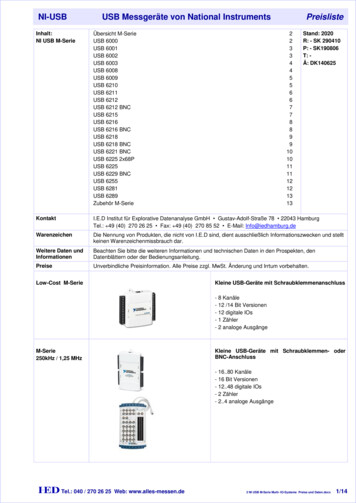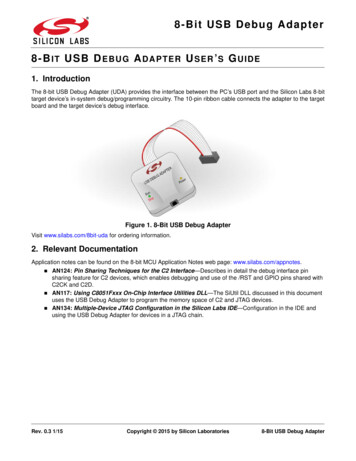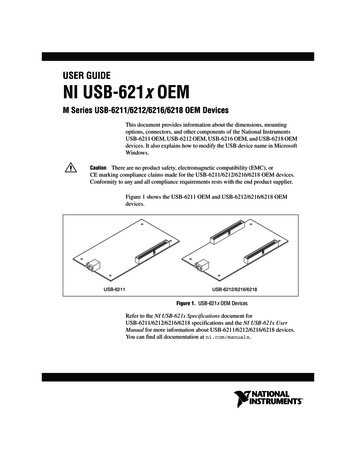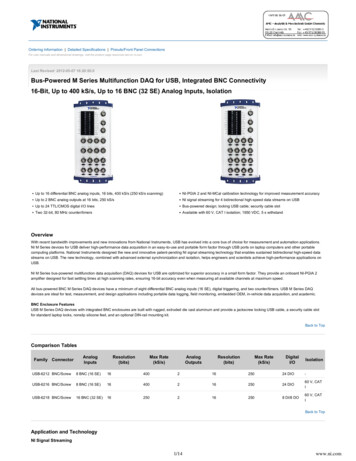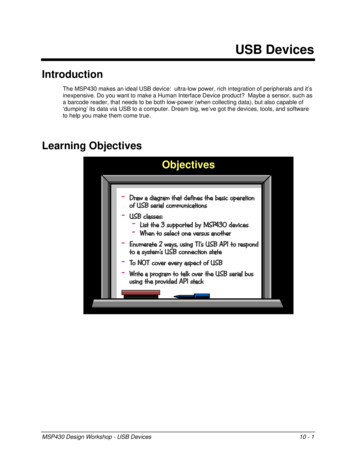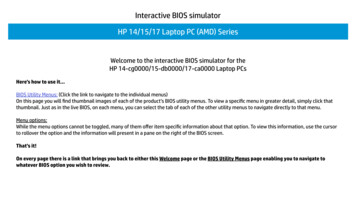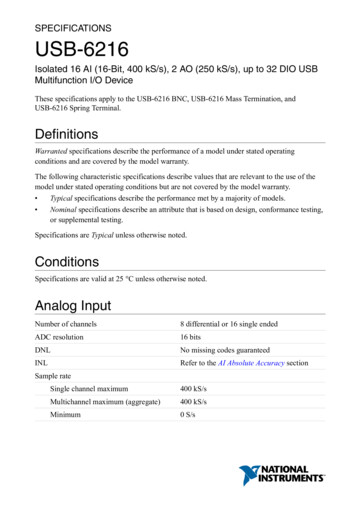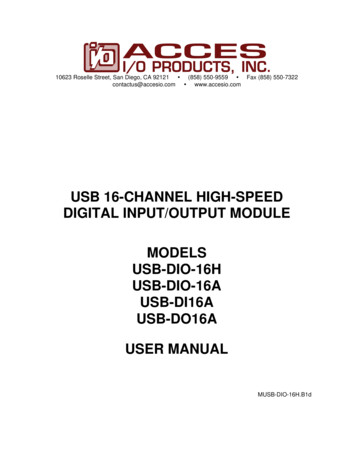
Transcription
Application NoteAN 180FT232H MPSSE Example - USB CurrentMeter using the SPI InterfaceRev 1.0Issue Date: 2011-10-17This application note gives an example of interfacing an FT232H device to twoSPI Analog-to-Digital Converters, to create a device which measures the VBUSvoltage and current flowing in a USB connection. A Visual Basic 2008 program isused to control the MPSSE on the FT232H using D2XX commands, to takereadings from the ADCs and display the results on the PC.Use of FTDI devices in life support and/or safety applications is entirely at the user’s risk, and the user agreesto defend, indemnify and hold harmless FTDI from any and all damages, claims, suits or expense resultingfrom such use.Future Technology Devices International Limited (FTDI)Unit 1, 2 Seaward Place, Glasgow G41 1HH, United KingdomTel.: 44 (0) 141 429 2777 Fax: 44 (0) 141 429 2758Web Site: http://ftdichip.comCopyright 2011 Future Technology Devices International Limited
Application NoteAN 180 FT232H MPSSE Example - USB Current Meter using the SPIInterfaceRev 1.0Document Reference No.: FT 000497Clearance No.: FT 225Table of Contents1Introduction . 21.1FT232H Device . 31.2UM232H Module . 31.3Other Modules. 32Example Circuit . 43Software . 943.1Command Set . 93.2Initialisation Code. 103.3Measurement Code . 103.4Charting Code . 113.5Closing the Device . 123.6Code Examples . 12Using the Demo . 154.1Driver Installation. 154.2EEPROM Contents . 154.3Running the Demo . 164.4Additional Notes . 175Schematic . 186Contact Information . 19Appendix A – References . 20Document References . 20Acronyms and Abbreviations . 20Appendix B – List of Tables & Figures . 21Appendix C – Revision History . 221Copyright 2011 Future Technology Devices International Limited
Application NoteAN 180 FT232H MPSSE Example - USB Current Meter using the SPIInterfaceRev 1.0Document Reference No.: FT 000497Clearance No.: FT 2251 IntroductionThis application note gives an example of using the Multi-Protocol Synchronous Serial Engine (MPSSE) onthe FT232H device. It uses D2xx commands to configure the MPSSE to interface with two Analog toDigital Converters (ADCs) using the Serial Peripheral Interface (SPI). It is controlled by software runningon the PC written in Visual Basic 2008. The example includes the following items: Discover FTDI devices connected to the computer and open the desired device Configure the MPSSE for SPI communication using D2xx commands (SPI Mode 0 in this case) Use Chip-selects to communicate with multiple SPI devices Configure GPIO to read and write values on the GPIO pinsThe application takes the form of a simple voltage and current meter, which can be connected in-linewith a separate USB link to measure the VBUS voltage and how much current the USB peripheral isdrawing from the host. An analog conditioning circuit is used to convert the voltage and current intosuitable ranges to be measured by the ADCs. The FT232H then reads these values from the ADCs andsends them through a separate USB connection to be displayed on the Visual Basic program.This application note details writing an application which controls the MPSSE directly, but a DLL is alsoavailable which contains functions to configure the MPSSE and communicate over SPI. Further details canbe found at: PSSE.htmFigure 1 below shows the circuit connected between the laptop and a mouse. It measures the VBUScurrent and VBUS voltage in the connection to the mouse (red line) and sends it to the laptop on aseparate USB connection (blue line). Two host ports are therefore required on the laptop.FT232H SPI Current MeterMeasurement CircuitFT232HComputer running measurement software andalso acts as host of USB link being measuredUSB mouseUSB link to FT232HFigure 1: Measuring the connection between a laptop and USB mouseFT232H SPI Current MeterMeasurement CircuitFT232HV2EVAL board is the host of the link beingmeasuredUSB WebcamUSB link to FT232HComputer running measurement softwareFigure 2: Measuring the current drawn from the V2-EVAL by the Webcam2Copyright 2011 Future Technology Devices International Limited
Application NoteAN 180 FT232H MPSSE Example - USB Current Meter using the SPIInterfaceRev 1.0Document Reference No.: FT 000497Clearance No.: FT 225The example in Figure 2 shows the circuit connected between the host port of a Vinculum-II V2EVAL (Rev2) board and a webcam to measure the current drawn by the camera. The V2EVAL board contains aVinculum II device, which is a 2-port USB host controller IC from FTDI. More information on this device,along with links to evaluation boards and application examples, can be found at the following 1.1 FT232H DeviceThis application uses the FT232H single-channel Hi-Speed device. However, the FT2232H and FT4232Hdevices also feature MPSSE engines and will be virtually identical in operation.Some features of the FT232H include:Single channel USB to serial / parallel ports with a variety of configurations.Entire USB protocol handled on the chip. No USB specific firmware programming required.USB 2.0 Hi-Speed (480Mbits/Second) and Full Speed (12Mbits/Second) compatible.Various interfaces includingo Asynchronous serial UART interface option with full hardware handshaking / modemsignals (up to 12Mbaud).o Multi-Protocol Synchronous Serial Engine (MPSSE) to simplify synchronous serial protocol(USB to JTAG, I2C, SPI or bit-bang) design (Up to 30 MBits/Sec).o Asynchronous 245 FIFO mode (up to 8 MByte/Sec).o Synchronous 245 parallel FIFO mode (up to 35 Mbyte/Sec).o Half duplex FT1248 interface with a configurable width, bi-directional data bus (1, 2, 4 or8 bits wide).o Bit-bang Mode interface option with RD# and WR strobesFTDI's royalty-free Virtual Com Port (VCP) and Direct (D2xx) drivers eliminate the requirementfor USB driver development in most cases.Highly integrated design includes 5V to 3.3V/ 1.8V LDO regulator for VCORE, integrated POROperation configuration mode and USB Description strings configurable in external EEPROM overthe USB interface.Configurable I/O drive strength (4, 8, 12 or 16mA) and slew rate.Low operating and USB suspend current.Supports self-powered, bus powered and high-power bus powered USB configurations.Compact 48-pin Lead Free LQFP or QFN packageMore details on this IC can be found at: http://www.ftdichip.com/Products/ICs/FT232H.htm1.2 UM232H ModuleIn this example, the UM232H module is used. This is a development module based around the FT232Hdevice. It can be plugged into a breadboard or IC socket and includes all components needed to getstarted immediately using the FT232H. For a more comprehensive feature list and technical details, heets/Modules/DS UM232H.pdf1.3 Other ModulesThe C232HM cables from FTDI, which are based upon the FT232H device, can also be used for thisapplication, in place of the UM232H. The flying leads provide all ADbus signals as well as a power output.For further details, see: tmThe FT2232H and FT4232H devices from FTDI also include MPSSE engines, and can be used instead ofthe FT232H. Evaluation modules are available for these devices at the links taSheets/Modules/DS FT2232H Mini s/DataSheets/Modules/DS FT4232H Mini Module.pdf3Copyright 2011 Future Technology Devices International Limited
Application NoteAN 180 FT232H MPSSE Example - USB Current Meter using the SPIInterfaceRev 1.0Document Reference No.: FT 000497Clearance No.: FT 2252 Example CircuitThe hardware consists of a small board with the UM232H and the analog circuitry as shown in Figure 3and Figure 4.Figure 3Figure 4Hardware used for the FT232H USB Current MeterPrototype board used for the FT232H USB Current Meter4Copyright 2011 Future Technology Devices International Limited
Application NoteAN 180 FT232H MPSSE Example - USB Current Meter using the SPIInterfaceRev 1.0Document Reference No.: FT 000497Clearance No.: FT 225The block diagram of the hardware is shown below. A full schematic can be found in Section 5.Link to computerrunning currentmeter softwareFrom host oflink beingmeasuredUM232H ModuleUSB ConnectorsUSB InUM232HTo peripheralof link beingmeasuredUSB OutCurrent and Voltage MeasurementGPIO OutputGPIO InputChip selectPowerSupplyMonitorChip SelectSCK / MISO linesCurrent Sensing de-by-2)12-bit ADC12-bit ADC5v0VregPower SwitchingDC:DCConverterPower Supply3.3VVregADCsPowerLEDStatusLEDLEDsFigure 5Block diagram of the hardwareThe main components are:UM232H ModuleThis evaluation module contains the FT232H device and all other circuitry required for the FT232H tooperate, such as the mini-B USB connector, the crystal and an EEPROM device to store custom settings.The datasheet at the link below contains further details of this ataSheets/Modules/DS UM232H.pdfPower SupplyThis design uses the FT232H PWREN# signal to enable power to the circuit once enumeration of theFT232H has completed. It also disables power when in USB suspend mode to meet the USB specificationof 2.5mA max in suspend mode. It uses a P-channel MOSFET to switch the 5V supply to the DC:DCconverter, which in turn powers the remainder of the circuit.A 3-way jumper allows the power to the DC:DC converter to be always-on (VBUS) or switched byPWREN# (VBUS SW)A DC:DC converter boosts the 5V power from the Power Switching circuit to 12V. Regulators are thenused to drop this 12V supply down to create a 5V rail for the current measurement amplifier and 3.3V forthe ADCs. This provides a more stable supply for the analog circuitry compared to powering the 5Vcircuitry and 3.3V regulator directly from the USB supply. Although not used here, it also provides anoptional 12V supply for other circuitry if required.5Copyright 2011 Future Technology Devices International Limited
Application NoteAN 180 FT232H MPSSE Example - USB Current Meter using the SPIInterfaceRev 1.0Document Reference No.: FT 000497Clearance No.: FT 225A supply monitor IC is used to detect when the supply to the analog circuitry fails or drops to a lowerthan normal value. The Microchip MCP120-450DI/TO was used in this application. It pulls its opencollector output low in this case, which is connected to an input GPIO pin on the FT232H. In addition toindicating to the application that the measurements taken may be invalid, this also provides an exampleof reading a GPIO pin using the MPSSE. The datasheet for the MCP120 can be found in the Appendix A –References section.ADCsThe circuit uses two 12-bit ADCs which are connected to the SPI interface of the UM232H. One ADCmeasures the output of the current sensing amplifier (which is adjusted via an output resistor to give a 0to 3.3V range), and the other measures the VBUS voltage via a divider (which divides the normal VBUSlevel of 5V by two as the maximum ADC input level is 3.3V). Although dual channel ADCs are available,two separate devices were used intentionally to demonstrate the use of the chip select in this case.The SPI Master In Slave Out (MISO) and Clock (SCK) lines are connected to both ADCs from the FT232H.Each ADC also has its own chip select (CS) line. Since the ADC does not require any data to be sent to itfrom the Master, the Master Out Slave In (MOSI) line is not connected. However, in other applications itwould be connected to the appropriate pin of the peripheral devices.SPI Mode 0 was used in this application, which means that data is clocked in on a positive edge and theclock idle state is low. The initial pin states of the FT232H and the MPSSE data commands were selectedto implement this mode in the MPSSE.The datasheet for the MCP3201-B ADC which was used in the prototype can be found in the Appendix A –References section.Current Measure ADCFT232HMOSI MISO SCKCSCurrent Measure ADCMOSI MISO SCKCSMOSIMISOSCKCS0CS1Figure 6SPI connections between UM232H and ADCsLEDsA pin is used to drive the green Status LED on the board. In this example, the LED is driven by one of theupper bits of the same port used for SPI. It is turned on by driving the pin low, and must be suppliedfrom 3.3V because this is the I/O level used on the pins of the UM232H module in this application. Toavoid noise on the 3.3V rail used for the ADC, the LED is powered from the 3.3V output provided by theFT232H device (which has its own internal regulator and can provide 3.3V to external circuits).The LED is turned on by the application software after the MPSSE is initialised and blinks off briefly eachtime a reading is taken. As well as indicating the status of the unit, it also presents an example of how tocontrol GPIO through the MPSSE.A red LED is powered from the 5V rail from the Power Switching circuit to indicate that the power isturned on.6Copyright 2011 Future Technology Devices International Limited
Application NoteAN 180 FT232H MPSSE Example - USB Current Meter using the SPIInterfaceRev 1.0Document Reference No.: FT 000497Clearance No.: FT 225Current and Voltage MeasurementThe current measurement circuit consists of a current sensing resistor and current sensing differentialamplifier. In this application, the Maxim MAX4172 was used. The datasheet can be found in the AppendixA – References section. This has further information on the device and recommendations for layout etc.The current flows between the 5V (VBUS) pins of the USB ‘In’ and USB ‘Out’ connectors through thecurrent sensing resistor, which converts the current flowing into a small voltage across the resistor. Inthis case, a 0.2R resistor is used which gives a range of between 0mV and 100mV depending on thecurrent flowing. This resistor was chosen because 0mV – 100mV is the normal input range for thedifferential amplifier which is used to measure the voltage across the resistor. At 500mA flowing, (0.2Ohms * 0.5 Amps) 100mV across the resistor.This method provides a reasonably accurate current measurement but is not entirely un-intrusive sincethe resistor will cause a corresponding voltage drop in the supply to the USB peripheral being measured.The selection of a resistor value depends on the amplifier
The example in Figure 2 shows the circuit connected between the host port of a Vinculum-II V2EVAL (Rev 2) board and a webcam to measure the current drawn by the camera. The V2EVAL board contains a Vinculum II device, which is a 2-port USB host controller IC from FTDI. More information on this device,
